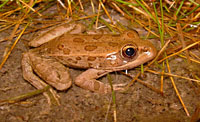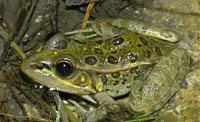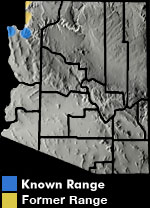Online Field Guide to The Reptiles and Amphibians of Arizona


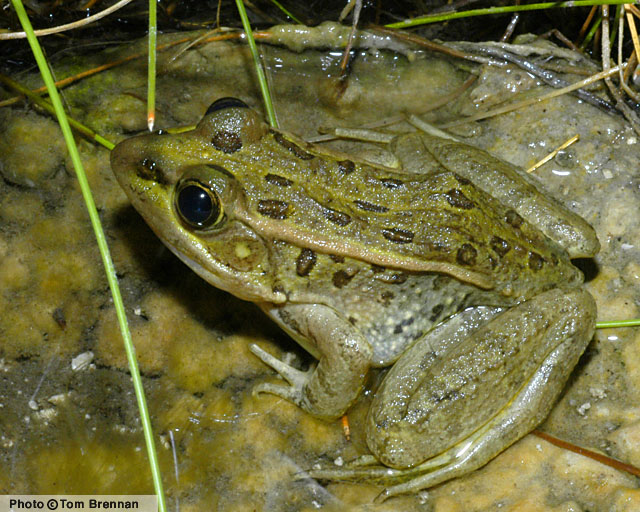
Relict Leopard Frog (Lithobates onca)
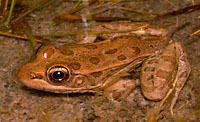 Clark Co., NV |
| RELICT LEOPARD FROG Lithobates onca | |
|
DESCRIPTION: The relict leopard frog is a relatively small (largest females >3 inches) leopard frog that is very similar in appearance to the lowland leopard frog. It cannot be reliably distinguished from the lowland leopard frog without genetic analysis; however, the two species are not known to occur together (but see note under “Distribution” for Grand Canyon). Relict leopard frogs have dorsolateral folds that are broken and inset towards the rear, a reticulate pattern on the rear of the thigh that may be fuzzy or quite bold, usually no spots on the snout, and relatively short legs. Color on the back and head ranges from light brown, tan, and dark olive-brown, to charcoal. Some frogs are green, mostly on the head. DISTRIBUTION: In Arizona, relict leopard frogs probably occurred historically along the Colorado and Virgin rivers and associated springs and tributaries. Its historical distribution along the Colorado River is unclear, but included at least Black Canyon (below Hoover Dam), probably portions of what is now Lake Mead, and perhaps upstream into the Grand Canyon. Recently discovered frogs in a tributary to the lower Grand Canyon are genetically similar to the lowland leopard frog, but share some characteristics with the relict leopard frog. In Arizona, the species has disappeared from its historical localities, but has recently been reestablished at three sites near Lake Mead. Drought followed by heavy flooding in October 2006 may have eliminated one of those populations. HABITAT: Historically it likely occurred <2,000 ft elevation in sloughs and backwaters, but also along the mainstems of the Colorado and Virgin rivers. They also occurred, and are currently limited to, off-channel springs and streams that have not been invaded by, or are unsuitable for, non-native predators. Numbers decline in springs or streams choked with vegetation. Heavy flooding and sedimentation in October 2006 reduced habitats for the species. BEHAVIOR: Can be found active day or night, but probably rarely move far from their wetland habitats. Often found in geothermally-heated springs with temperatures >86 degrees F. DIET: Relict leopard frog presumably feed upon a wide variety of invertebrates. REPRODUCTION AND CALLS: Breeding has been noted from late January through March, but also September and November. Spherical egg masses of several hundred eggs are attached to vegetation at or near the surface. Captive tadpoles metamorphosed in 6.5 months. Adult males give a soft, stuttering call similar to the lowland leopard frog. REMARKS: Lithobates onca is a sister taxon of the Lowland Leopard Frog and may be the same species. This is one of the rarest frogs in North America; numbers probably declined due to predation by non-native species and habitat alterations. The total relict leopard frog population in the late 1990s was estimated at about 1,100 metamorphosed frogs. The frog is a candidate for Federal listing; its conservation is being addressed by a multi-party conservation agreement and strategy. By Jim Rorabaugh PROTECTED Bradford, D.F., R.D. Jennings, and J.R. Jaeger. 2005. Rana onca Cope, (1875), Relict leopard frog. Pages 567-568 in M.J. Lannoo (ed), Amphibian Declines: The Conservation Status of United States Species. University of California Press, Berkeley. Brennan, T.C., & A. T. Holycross. 2006. A Field Guide to Amphibians and Reptiles in Arizona. Arizona Game and Fish Department. Phoenix, AZ. Jaeger, J.R., B.R. Riddle, R.D. Jennings, and D.F. Bradford. 2001. Rediscovering Rana onca: Evidence for phylogenetically distinct leopard frogs from the border region of Nevada, Utah, and Arizona. Copeia 2001: 339-354. Relict Leopard Frog Conservation Team. 2005. Conservation agreement and rangewide conservation assessment and strategy for the relict leopard frog (Rana onca). Relict Leopard Frog Conservation Team. |
|
Visit Partners in Amphibian and Reptile Conservation:


HOME
Copyright © 2023, Arizona Game and Fish Department. All rights reserved.
If you make use of the textual contents of this site in reports, publications, etc. please cite and credit the author(s) and photographer(s). All photos on this website are copyrighted. However, those found in the species account section may be used for any noncommercial scientific, educational, or conservation purposes provided that photographs are not altered and continue to bear the copyright symbol and name of the photographer. Please contact the photographer regarding commercial use of copyrighted photographs.










